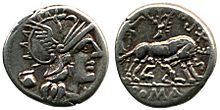Ficus Ruminalis
The Ficus Ruminalis (about Ruminalischer fig tree , also Ruminalischer Baum , arbor Ruminalis or rumina ficus ) was a fig tree at the Roman Forum in ancient Rome.



mythology
Legend has it that Romulus and Remus were abandoned as babies in a basket on the Tiber. The basket in which the children were sitting got stuck on the ficus ruminalis. There she found a she-wolf who was suckling the children. The name can therefore be derived from the Latin rumis ("teat"). A sanctuary to the goddess Rumina , whose cult is linked to Romulus and Remus, was located near the tree.
history
With regard to the topography of the Romulus legend, two locations of the fig tree have been tangible through written sources since the literary treatment in Augustan times. As early as the Roman royal period , the tree is said to have been miraculously moved from the Palatine to the Comitium near Lacus Curtius by Augur Attus Navius , after which it had been on the forum for more than 500 years at the time of Titus Livius . Accordingly, the former location would be the one on the slope of the Palatine Hill near the Lupercal . The fact that the name ficus Ruminalis has been handed down for both places at a later date may be due to confusion. Possibly the old location kept the name or a tree was replanted. The confusion could also have been caused by the fact that a statue of Attus Navius by Livy is attested for the location on the Palatine Hill. At the new location on the Comitium there was a bronze group depicting the twins and the she-wolf, which, according to Dionysius of Halicarnassus, is also said to have been consecrated under Attus Navius.
The fate of the Ficus Ruminalis was linked to that of the state due to their mythological significance and location. If the tree died, this was considered an ominous omen and it had to be replanted by the priests. Such a case is documented by Tacitus for the year 59 AD in the reign of Emperor Nero .
In the 20th century, three fig trees were again planted at the presumed site of the Comitium .
literature
- Filippo Coarelli : Rome. An archaeological guide. Verlag von Zabern, Mainz 2000, ISBN 3-8053-2685-8 , pp. 70, 73 and 85.
- Christian Hünemörder : Feige. In: The New Pauly (DNP). Volume 4, Metzler, Stuttgart 1998, ISBN 3-476-01474-6 , column 456 f.
- Kurt Latte : Roman religious history. Beck, Munich 1960, reprint 1992, ISBN 3-406-01374-0 , p. 111f. ( Handbook of Classical Studies . Section 5, Part 4).
- Franz Olck : fig. In: Paulys Realencyclopadie der classischen Antiquity Science (RE). Volume VI, 2, Stuttgart 1909, Col. 2100-2151.
- Friedrich Pfister : Rumina. In: Paulys Realencyclopadie der classischen Antiquity Science (RE). Volume IA, 1, Stuttgart 1914, Col. 1225 f.
- C. Robert III. Phillips: Rumina. In: The New Pauly (DNP). Volume 10, Metzler, Stuttgart 2001, ISBN 3-476-01480-0 , Sp. 1160.
- Ficus Ruminalis . In: Samuel Ball Platner , Thomas Ashby : A Topographical Dictionary of Ancient Rome . Oxford University Press, London 1929, p. 208 ( online at LacusCurtius).
Individual evidence
- ↑ Babelon: Pompeia 1; Sydenham 461; Crawford 235 / 1a.
- ↑ Titus Livius : " ab urbe condita " 1, 3, 5; Pliny the Elder : Naturalis historia 15, 77; Varro : De lingua Latina 5, 54.
- ↑ Festus 326, 332f .; Varro: De lingua Latina 5, 54; Christian Hünemörder : Feige. In: The New Pauly (DNP). Volume 4, Metzler, Stuttgart 1998, ISBN 3-476-01474-6 , Sp. 457. C. Robert II. Phillips: Rumina. In: The New Pauly (DNP). Volume 10, Metzler, Stuttgart 2001, ISBN 3-476-01480-0 , Sp. 1160 (with different views).
- ↑ Varro, De re rustica 2, 11, 5.
- ↑ Dionysius of Halicarnassus 3, 72.
- ^ Livy 1:36 .
- ^ Dionysius 1, 79.
- ↑ Festus 270.
- ^ Tacitus: Annals 13, 58.
- ^ Coarelli p. 85.